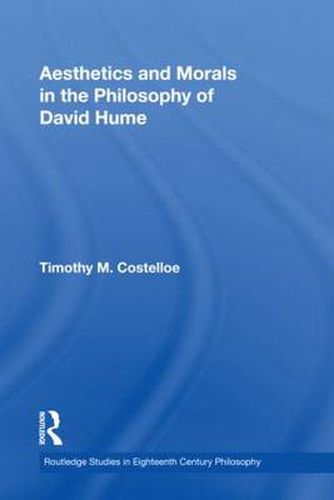Aesthetics and Morals in the Philosophy of David Hume
Timothy M Costelloe,Timothy M Costelloe (College of William and Mary, Virginia College of William and Mary, USA College of William and Mary, USA College of William and Mary, USA College of William and Mary, USA)

Aesthetics and Morals in the Philosophy of David Hume
Timothy M Costelloe,Timothy M Costelloe (College of William and Mary, Virginia College of William and Mary, USA College of William and Mary, USA College of William and Mary, USA College of William and Mary, USA)
The book has two aims. First, to examine the extent and significance of the connection between Hume’s aesthetics and his moral philosophy; and, second, to consider how, in light of the connection, his moral philosophy answers central questions in ethics.
The first aim is realized in chapters 1-4. Chapter 1 examines Hume’s essay Of the Standard of Taste to understand his search for a standard and how this affects the scope of his aesthetics. Chapter 2 establishes that he treats beauty in nature and art and moral beauty as similar in kind, and applies the conclusions about his aesthetics to his moral thought. Chapter 3 solves a puzzle to which this gives rise, namely, how individuals both accept general standards that they also contravene in the course of aesthetic and moral activity. Chapter 4 takes up the normative aspect of Hume’s approach by understanding moral character through his view of moral beauty.
The second aim of the book is realized in chapters 5-7 by entertaining three objections against Hume’s moral philosophy. First, if morality is an immediate reaction to the beauty of vice and the deformity of virtue, why is perfect virtue not the general condition of every human individual? Second, if morality consists of sentiments that arise in the subject, how can moral judgments be objective and claim universal validity? And third, if one can talk of general standards governing conduct, how does one account for the diversity of moral systems and their change over time? The first is answered by showing that like good taste in aesthetics, ‘right taste’ in morals requires that the sentiments are educated; the second, by arguing against the view that Hume is a subjectivist and a relativist, and the third (chapter 6), by showing that his approach contains a view of progress left untouched by any personal prejudices Hume himself might harbor. The book concludes in chapter 7 by showing how Hume’s view of philosophy affects the scope of any normative ethics.
This item is not currently in-stock. It can be ordered online and is expected to ship in approx 2 weeks
Our stock data is updated periodically, and availability may change throughout the day for in-demand items. Please call the relevant shop for the most current stock information. Prices are subject to change without notice.
Sign in or become a Readings Member to add this title to a wishlist.


